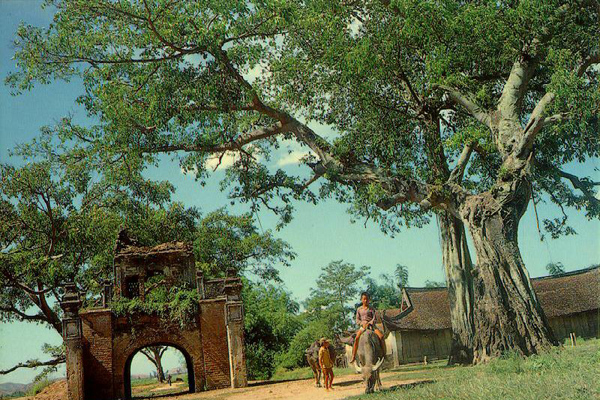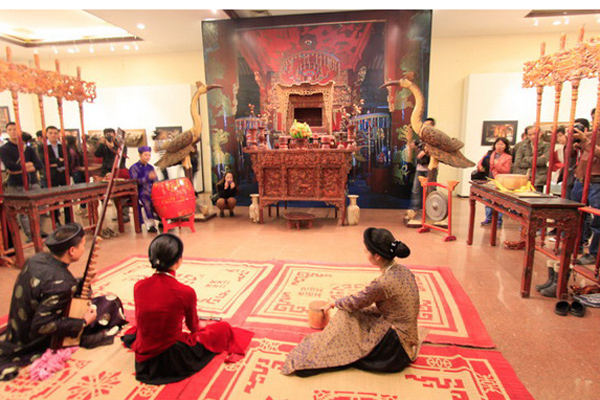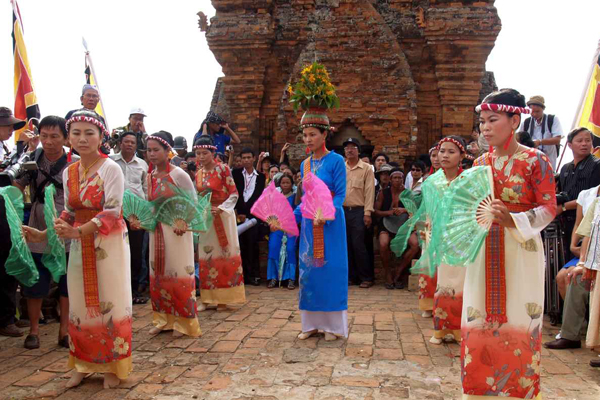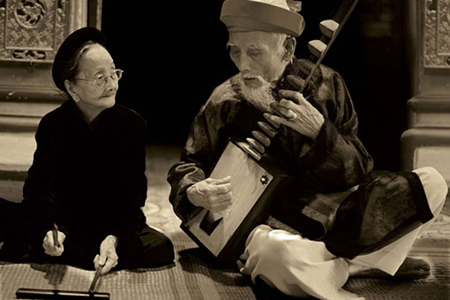Despite the great prestige of Chinese culture, the indigenous Viet culture was preserved through all the years of occupation and borrowings thanks to the solid bastions formed by the villages which had grown out of the pre-historic agricultural communes.
Over the millennia, the Vietnamese nation took shape through the spread of villages (to be understood here in the sense of rural communes), which were political, social, and economic units where a close-knit cooperation was forged in the incessant struggles both against nature (the system of dykes) and against invaders and brigands.
Community identity was reinforced by numerous other factors as well.
On the administrative level, the Viet village represented an autonomous unit of state organization. The administrative network established by the Chinese courts only extended as far as the province and district; the impact of Chinese culture weakened behind the bamboo curtain of the village.

During the period of national independence, this indirect cultural influence was always muted. ‘The King’s decrees’, according to a popular saying, “yield to the customs of the village”.
Thus two parallel cultural systems existed on a national scale; a learned culture that was marked by heavy Chinese influences and a village culture that was more faithful to the root culture of the Viet.
Vestiges of a primitive communal organization persist within the village, working against the hierarchical spirit of official Confucianism.
The Giap, for example, is an egalitarian and democratic association to which men belongs as members of age groups, regardless of their titles, occupations, or fortunes. Its purpose is to accomplish certain ritual and social functions.
Another example is the redistribution every three, four, or six years of inalienable communal rice fields to those entered in the village lists. Despite the accelerating development of the private ownership of land, the kings always tried to save the communal lands in order to limit the risk of brigandage and peasant uprisings; in addition, the communal properties brought in more taxes than the private lands.
The village is also the depository of the spiritual and artistic traditions of the nation. The ancestors, whose worship is deeply rooted, sleep in the rice fields. Each village possesses temples where spring and autumn ritual feasts are celebrated, the occasions for public communion and gaiety. Each shelters numerous architectural and sculptural treasure; 80% of the national patrimony, it is estimated. is to be found in villages. Many villages take great pride in such craft specialties as silk, mother-of-pearl inlay, wood carving, and wood block prints.
The village secures the spiritual life of its inhabitants through the presence of a communal house, a pagoda, an altar to Confucius, and little shrines for non-institutionalized beliefs.
Within the bamboo hedge of the village Confucianism loses much of its rigor and prudery. Although the altar mound (van chi) pays solemn homage to Confucius and his local disciples, the strongly hierarchical Confucian order reflected in the communal house (dinh) suffers many transgressions due to the pre-Chinese culture.
This edifice, center of the village’s collective life, plays the combined role of a temple, a town hall, and a cultural center. It is the sanctuary of the tutelary god, who is not a Chinese god or hero, but rather Vietnamese: perhaps a great warrior who won distinction in the struggle against the Chinese invaders, or a mandarin who taught the village the craft that earns its living, or sometimes a simple beggar or thief who died at an auspicious moment.
And some spring festival rituals give rise to public displays that are very un-Confucian indeed: tournaments where boys and girls sing to each other in playful repartee; mock battles waged for a beggar’s stick and bag; an imitation of amorous play, in the pattern of fertility cult rituals. Many communal houses from the 17th and 18th centuries are still graced with lusty scenes carved in wood. Among villagers, Confucianism is reduced to a sum of family and social practices adjusted to fit with popular common sense.
Those candidates who failed in the difficult triennial exams, and mandarins retired from the court – who were often schoolmasters – formed the rural intelligentsia; they shared with the peasants their hopes, their joys, and their sorrows.
Some of them rallied to support the peasant revolts, contrary to Confucian tradition. Many proverbs and popular songs played yet another counterpoint to official morality.
Confucianism came in several shades: the orthodox doctrine of the court, that of the humanist mandarins who were close to the people, and that of those who made common cause with the villagers.
Consecrated to Buddha, the village pagoda (chua) preached charity and showed more metaphysical concerns. The peasants, who labored under the dual afflictions of rice cultivation and the feudal system; went there to seek a bit of comfort.
In Vietnam, Sakyamuni’s faith from India quickly aligned itself with the Greater Vehicle from China, and its sutras were studied through Chinese translation.
But from its beginnings Vietnamese Buddhism incorporated the ancient beliefs of pre-Chinese Southeast Asia. The fertility cult gods of those who plant rice. In flooded fields were super-imposed on Buddhism.
Let us take, for example, the Dau (pronounced Zau) pagoda erected at Luy Lau. It is part of a chain of sanctuaries that venerate four Buddhist goddesses: Cloud, Rain, Lightning, and Thunder. These are invoked in times of prolonged drought.
The Vietnamese created as well their own Bodhisattva of Mercy (Avalokiteshvara), called Quan Am Thi Kinh in the image of a martyred woman who found salvation after enduring monstrous injustices. The Buddha, shrouded in the metaphysics of Being and Non-being, in popular hands becomes But, a benevolent and good-natured “Grampa“that hears the cries of unhappy children and downcast adults
It is not without reason that Confucian scholars reproached this religion that cared so little for the affairs of this world. As the Confucianist Le Quat complained, ‘princes of royal blood and commoners alike, as soon as it is a question of Buddhism, squander their fortunes on the pagoda, happy as if they held in their hand a ticket to heaven.”
But that did not stop the three doctrines thought to have the same root – Confucianism. Buddhism, and Taoism from living together quite well, the same person often practicing all three. Nguyen Du (18th century), for example, a confirmed Confucian scholar, is haunted by Buddhist karma in his immortal work, the Tale of Kieu.

There has never been a religious war because the Vietnamese, whose practical spirit turns towards the concrete, are far from being fanatical. As Confucianism took on shades of Taoism and Buddhism, it becomes understandable that Buddhist Bonzes under the Ly consecrated themselves to the politics of the state; the Tran kings retired to the pagodas after having conquered the invading Mongols, and retired mandarins opted for an Epicurean Taoism.
The philosophy of Taoism is too esoteric for the populace. But one of its branches, which tend towards magic and spiritualism in its quest for eternal life, blends with the animist beliefs that date from prehistoric Southeast Asia. This resembles Shintoism, but with no exaltation of the Emperor and of the race.
The religious feelings of a large majority of the population take shape in the cult of a providential Heaven (the Jade Emperor), in the spirits of the forest, rocks, rivers and trees, in the ancestors of the family and the nation, and in the deification of great men and heroes.
As a balance to Confucianism, which consecrates the supremacy of men, there is a popularly instituted cult of the Holy Mothers. These deeply rooted popular beliefs have special sanctuaries, and often filter into the Buddhist pagoda as well.
In the process of acculturation in Vietnam, the impact of Chinese culture should not make us forget the exchanges between this country and its Southeast Asian neighbors, who were all Indianised states: Champa, Nam-Chieu, Lan Xang, the Khmer kingdom, and Siam.
These reciprocal influences are unfortunately less well- known than the conflicts that made them opponents in the struggle to affirm their national identities.
The influence that left the deepest mark on Vietnam is without a doubt that of Champa, which practically fused with Vietnam in the 16th and 17th centuries.
The region of Hue, former border land market that became the royal capital in the 19th century, bears witness to this blend with its complex and refined culture. The music of Hue combines Cham and Chinese influences with an indigenous base.
It would be a mistake to think of the union of Champa and Vietnam as a lightning annexation made by an all- powerful Vietnam. It is rather the result of a centuries-old rivalry between two neighbor countries which were, at the start, almost equal in strength.
Champa declared its independence in the 2nd century, while Vietnam was still under the yoke of Chinese domination.

The real battle began from the 10th century, after Vietnam had regained its independence. Over the course of this armed rivalry, interrupted by truces and even alliances, each side new highs and lows. Attacks and counter-attacks followed each other over the course of centuries.
From 1371- 1377, the Cham King Che Bong Nga seized and pillaged the Vietnamese capital Thang Long (Hanoi). His death marked the decline of Champa which succumbed to internal dissension and to attacks by Vietnamese and Khmer.
The Vietnamese royalty added to its domain land in the Mekong region that nominally belonged to the Khmer kingdom. These lands, uncultivated and practically without master, were cleared and planted by Vietnamese, Chinese, and Khmer immigrants.
The contribution of the Khmers to Vietnamese culture is important because, like the Cham and the Chinese, they are an ethnic minority group that forms an integral part of the Vietnamese population.



